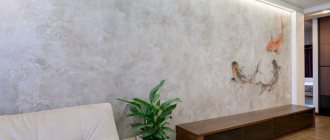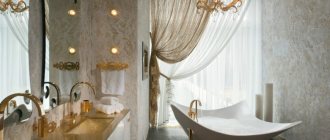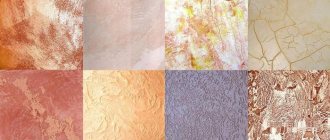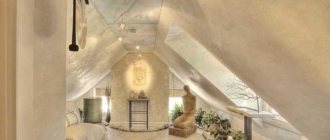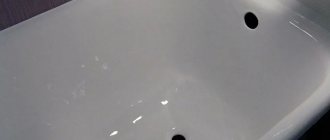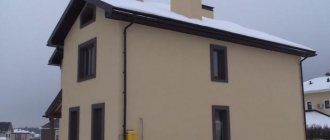Your bath requires sophisticated decor - try Venetian plaster. It is made from marble dust, onyx, granite or other expensive types of stones. In accordance with accepted technologies, builders add natural pigments and slaked lime to the mass. The current option involves the use of piece dyes together with acrylic adhesives. Venetian plaster in the bathroom transforms the room in every way. Marble dust creates shimmer and deep light. Polymer components prevent cracking and extend the service life of this type of decor.
Modern technologies answer the question: is it possible to do a Venetian in the bathroom? An innovation is considered to be silicone Venetian plaster, made specifically for damp environments. The mixture is not afraid of dampness and temperature changes.
Shower sections and vertical structures close to the bathtub should not be covered in this way. Plaster is not friendly with water. For these places, transparent glass and sealant at the joints are used.
Once Venetian plaster is installed, the finished top coat will prevent bacteria from growing in a damp room. This finish in the bathroom does not emit harmful substances and is considered environmentally friendly.
Bathroom finishing features
Before we talk about the finishing features, let's define what Venetian plaster is. This material can be classified as one of the types of textured plaster with water-repellent properties. It is designed for use in damp areas.
Its feature: the presence of a special moisture-proof layer.
The use of the material in question will allow you to treat the bathroom walls to look like marble and/or granite.
The bathroom can get a colorful color and sparkle with new colors every day, delighting you. Venetian plaster in the bathroom can be applied not only to the walls, but also to the ceiling, which will give the room sophistication and individual style.
How to make a rough “bark beetle” coating with your own hands
To create such a coating, small granules are added to the finishing mixture.
Plaster the walls like this:
- A base coat is applied over the rough layer. It is leveled using the rule, eliminating protrusions.
- After the base has partially set, plaster with granules is applied. The dried surface is treated with a construction float. The granules scratch the coating, forming indentations. Hand movements create the desired pattern.
You can see in the photo what the surface will look like after finishing.
Types of decorative plaster for the bathroom
Many of you have probably come across the classic type of finishing material that imitates marble. Decorative finishes can give the workspace a silver, gold or pearlescent hue.
Less commonly, there are rooms whose walls are made of malachite, jasper, or the same granite.
Let's take a look at the most common types, which include:
- Veneto.
- Trevignano.
- Marbello.
- Ensausto.
Read more about each of them below.
Veneto type
Today it is a common classic that imitates marble. Its special feature: thorough polishing.
Trevignano type
It falls into the category of decorative coating. Feature: there is an internal lighting effect, which creates the semblance of a marble wall with a mirror tint. Venetian plaster for a bathroom of this type, thanks to translucent layers interspersed with colored spots, allows you to achieve a stunning, non-standard effect.
Marbello type
With its help, the effect of roughly processed marble is achieved. Feature: unusual shades can be achieved through the play of light.
Ensausto type
Coating with this type of plaster will give the walls a semi-matte tint with droplets reminiscent of granite.
Examples of designs and drawings
Photographic examples of the most interesting drawings and projects.
Gloss
Quite a common decor option. The glossy surface is created using a layer of finishing or polishing wax. This texture is very pleasant to the touch and has an incredibly amazing shine.
Nacre
Adding mother-of-pearl to the plaster mixture creates an iridescent effect with a subtle shimmer and subtle pearly sheen. This textured material allows you to create truly exclusive and original interiors.
Colored (two-color or more)
Various combinations of shades or color transitions in the form of a gradient are perfect for decorating any style direction and will become a bright and expressive touch of the entire room.
Under gold
With the use of this exquisite gold decor, it is possible to fill the atmosphere with luxury, wealth and grandeur, without going beyond aesthetic boundaries.
Under concrete
It has an unusual appearance and high performance. Such a unique slightly rough texture, which does not have a pronounced relief, is achieved by adding small pebbles and sand.
Silk
Wet silk has a rich texture with a unique signature. This decoration creates incomparably beautiful visual effects that turn the room into a real palace apartment. The silky texture is achieved through the use of shiny fibers and elements.
Sand
Such multifaceted decor can have a different appearance, for example, create imitation of river sand, sandy wind or dunes.
World map
The scattered outlines of continents and islands painted on the surface seem exclusive and bring the spirit of travel to the environment.
Marbled
The famous marbled plaster is called “Marmorino”. Literally meaning "little marble" in Italian, tiny marble particles are mixed with lime to create a smooth, smooth plaster.
Its surface is smooth, shiny and, thanks to the craftsmanship, it smoothly transitions light from shadow, which gives a sense of depth and reflects light well. Such a wall will be smooth and cold to the touch.
Marmorino can be applied to interior and exterior surfaces and is suitable for both modern and historical interiors. It has anti-mildew properties, excellent waterproofing and antibacterial properties, making it highly desirable for luxury bathrooms and other wet areas. The aftertaste intensifies with age.
it is the most versatile of the Italian plasters and can be used to create a variety of textures, from polished marble to rough, rough natural stones such as travertine. It can be smooth or marbled. It can have different levels of shine depending on how long it has been polished. The finish can be enhanced with colored pigments.
Marmorino is available in various grains and has many shades and decorative effects:
- thin marmorino;
- classic marmorino;
- matte marmorino.
Fine marmorino is suitable for obtaining a smooth and polished surface with a glossy effect and a wonderful play of light and shadow. With a larger marbled texture, the classic Marmorino exhibits exquisite craftsmanship with a brilliant shine. Matte marmorino is similar to modern tadelakt, where the surface is smooth, smoothed to satin with a flat decorative effect.
Brilliant
This is a high gloss plaster with a real "wow" factor. Made from very fine marble dust, it is applied in thin layers and the final layer is polished to create an extraordinary shine and deep reflection.
With a shine like a flawless mirror, this plaster is fresh and sensual to the touch. Unlike paint, this product is highly reflective in the corner and has little reflection from the front.
It is a wall and ceiling finish suitable for almost any interior space, suitable for both modern and classic spaces, as well as residential and commercial spaces.
Metal
Modern design uses less and less natural mother-of-pearl, which in ancient times was mined by grinding shells. The most appropriate was to use metal to achieve a similar effect.
This finish has a special shine and a pleasant chromatic effect, suitable for prestigious interiors. The metallic effect is achieved by adding large amounts of very fine multi-colored metallic powder instead of the usual marble powder. Available in silver, gold, bronze.
Has a special shine and attractive color effect
This gloss plaster has a glossy appearance, a subtle velvety finish that changes depending on the refraction of light from the surface and viewing point. Metallic Venetian plaster will decorate any modern room; it looks especially organic in high-tech, high-tech design. They also look great in a dining room, office, restaurant, living room or bathroom. Instead, you can use it on your living room walls or pair it with antique furniture to create amazing contrasts.
Travertine
This finish imitates the famous travertine - a special form of light-colored limestone - can be white, brown, cream, even rust-colored and has a fibrous or concentric appearance. Travertine effect plaster has a subtle stone effect with varying degrees of soft consistency, depending on the grain size and method of application.
The surface has a slight sheen to it, and although it only comes in one shade, it has two or three different shades that cover the entire surface. This finish can work well with any color, and subtle tonal contrasts can be achieved in both light and dark shades. The features of this textured plaster give it warmth and coziness.
Embossed
is a fibrous gypsum that is used to create dense textured surfaces or uneven textured ground by incorporating a special ingredient: horsehair.
It is a fibrous plaster used to create dense and structured surfaces. Suitable for creating an antique effect, for finishing and coloring decorative objects, such as mother-of-pearl or metallic wax.
Venetian plaster in the bathroom
The mixture contains natural materials of natural origin. The mixture is distinguished by the absence of sharp and unpleasant odors. Venetian plaster in the bathroom does not emit toxic substances, which allows us to talk about its cleanliness in terms of ecology.
Polymer additives used in the mixture virtually eliminate the risk of deformation and protect the coating from cracks.
For your information!
Once applied, Venetian plaster can last ten years or more if properly cared for.
After applying Venetian plaster, when the coating is ready, it will fight against the manifestation of fungus and mold, which can appear in rooms with high humidity.
note!
Another feature of the material we are considering is that it can withstand temperature changes and
splashes of water.
Defects that may appear after water drops hit the walls can be easily restored without completely replacing the finish.
Another advantage is the pleasant shine of the material used, creating luxury.
There are drawbacks, but not many. The main thing is the high cost of finishing. And also, the labor-intensive process of preparing the surface, leveling the walls and the need to comply with the technological process, which we will discuss below.
Plaster application technology
The main feature is the application of plaster in three layers. But, before this, work is carried out to level the working area. Preparing walls for plastering in a bathroom includes the process of applying several layers of a special sanitizing substance.
The material promotes leveling and acts as an additional waterproofing layer. Acts as a barrier to salts and serves as a microclimate regulator in a damp room.
If there was previously tile in the bathroom, you can refuse to dismantle it by covering it with a plasterboard structure. It is necessary to take into account that it (plasterboard) will eat up part of the free space. Small rooms will be especially affected.
The places where the plaster comes into contact with other finishing materials should be covered with a moisture-resistant sealant. After the walls are leveled and dry, they begin to apply the coating.
Application instructions
In this work, it is necessary to follow the principle of sequential surface treatment in several layers.
The minimum quantity is three. The first layer is applied with a rectangular spatula. Movements should be short and rounded. The working thickness of the first layer is 1 millimeter.
They need to cover everything, leaving no gaps. Then, you should pause and let the plaster dry. This is approximately 2-2.5 hours.
When the surface is dry, you can sand it using a steel spatula or fine sandpaper: from 0 to 2.
Advice!
When treating the surface, remove dust using a regular paint brush.
The second layer consists of asymmetrical short strokes, which are immediately rubbed at a slight angle. Tool: spatula. In working slang this technique is called a “butterfly”.
When treating the surface with a spatula, excess material is removed and pressed into the bottom layer. The result should be veins that create the effect of monolithic marble.
It doesn’t matter how many layers are used: 3 or 5, the crown of the work will always be treating the walls with a special wax coating, which creates gloss, enhances shine and internal glow. You can give a certain shade - matte, pearl or shimmer - using different shades of wax.
Note!
Application of wax is possible no earlier than 7 days after laying the last layer of plaster.
Surface treatment is carried out with a special glove, followed by a grinding process with a special machine with a pile pad.
Remember,
that an excess of waxy layer can lead to the appearance of dark spots. Do not overdo it.
Advantages
The main positive characteristics of all decorative types of plaster include:
- moisture resistance;
- protection against mold and mildew;
- durability;
- vapor permeability;
- air exchange;
- high adhesion;
- ease of application;
- ease of care;
- durability;
- antistatic effect;
- individual design;
- combination with other surfaces;
- does not collapse under the influence of ultraviolet rays;
- maintains warmth;
- affordable prices.
Using a variety of designs and textures, you can give the room an original look.
When performing plastering work, you must adhere to certain rules. The coarse mixture is applied manually. The composition is diluted with the components specified in the attached instructions. People without experience and skills in this field should contact a professional.
Care
Only after a month can we say that the drying process is complete: the material has acquired its characteristic stability. This is a feature of Venetian plaster.
During the transition period, it is important to be careful about the work done. Avoid splashing water on the walls.
You can treat the surface with a damp sponge. Dirty places are “removed” with detergents. The use of solvents and/or hard scourers and abrasive powders is unacceptable.
What color is the Venetian?
The most popular colors.
White
It allows you to advantageously enhance, highlight and emphasize other shades and decorative elements in the interior. Use white, grey-white or ivory to create a perfect and fresh design.
The photo shows a wall finished with white and gray Venetian plaster.
Blue
It will bring special sophistication and sophistication to the atmosphere and create a relaxing and calm interior.
Grey
The elegant and unique shade of gray is very practical. Undoubtedly, this will add some aristocracy to the room.
Black
Create rich, bold and contrasting accents in your interior. A room decorated in black will look modern and noble and will take on a more expressive and clear look.
Green
It evokes heat, summer and fresh herbs. This color creates a comfortable environment and makes it interesting, unusual and very colorful.
Turquoise
It has special brightness and saturation. Turquoise color radically transforms the room and, undoubtedly, becomes its main accent.
Beige
Classic light beige shades in the interior look restrained, calm and elegant. Thanks to their neutrality, it is possible to create a discreet design and visually expand the space.
Blue
Incredibly delicate and sophisticated blue color creates a soulful and soft atmosphere.
The photo shows a children's room and walls lined with blue Venetian mother of pearl.
Silver
Fills the room with mysteries and moonlight. Silver tones, thanks to their alluring iridescence, create bold sparkling accents in the room.
